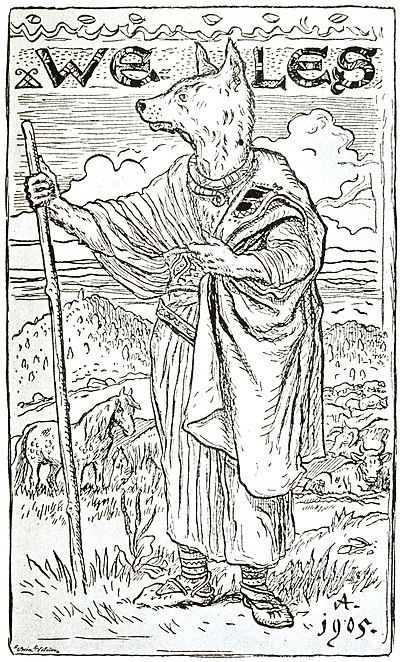The Mythology of All Races/Volume 3/Slavic/Part 3/Chapter 5
CHAPTER V
VELES, VOLOS, AND STRIBOG
VELES, the god of flocks, was held in high honour by the Russians, who swore by him as well as by Perun when making a treaty;[1] and old Russian texts often mention him in connexion with the more famous divinity.[2] When Vladimir was baptized in 988, he caused the idols of Veles to be thrown into the river Počayna;[3] another stone statue of the same deity, worshipped by the Slavic tribes in the neighbourhood of Finland, was destroyed by Abraham of Rostov, who preached Christianity on the banks of the Volga in the twelfth century;[4] and the Slovo pluku Igorevě[5] calls the minstrel Boyan "the grandson of Veles."
The memory of Veles still lives among the Russian people. In southern Russia it is customary at harvest-time to tie the last handful of ears into a knot, this being called "plaiting the beard of Veles" or "leaving a handful of ears for Veles's beard"; and in some districts a piece of bread is put among such ears, probably as a reminiscence of the sacrifices offered to Veles.
Veles was well known among the ancient Bohemians likewise, and his name frequently occurs in old Bohemian texts, although its original meaning has so utterly disappeared that the word now signifies simply "the devil."[6]
After the introduction of Christianity the worship of Veles was transferred to St. Blasius, a shepherd and martyr of Caesarea in Cappadocia, whom the Byzantines called the guardian of flocks.[7] In this capacity the saint is still venerated in Russia, Bulgaria, and even in Bohemia; and the shepherds, PLATE XXXV
Veles
This deity of flocks corresponds to the Ganỹklos (Dė̃vas), or "(God) of Pasture," of the pagan Lithuanians. This representation, from a picture by N. Aleš, is highly idealized (cf. his conception of Svantovit, Plate XXXIV, 1, as contrasted with the ancient statue reproduced in Plate XXXI).

when driving their flocks to pasture, recite ancient prayers which are expected to secure his protection.[8]
Stribog, whose idol stood on the hill in Kiev beside that of Perun,[9] was most probably the god of cold and frost; and in the Slovo pluku Igorevě[10] the winds are called the grandsons of Stribog. The conception of the winds as the result of cold and frost is easily understood.
The chronicler Cosmas testifies[11] that the Bohemians worshipped deities similar to Jupiter, Mars, Bellona, Ceres, etc., and that they made idols of them; but the names of these gods have not been preserved, and nothing positive is known concerning their worship. Numerous names of divinities worshipped by the pagan Poles are recorded by the chronicler Długosz,[12] but his report, belonging to a later period, seems to be influenced by Classical and Christian thought.
- ↑ Nestor, xxi, xxxvi (tr. Leger, pp. 24, 59).
- ↑ Cf. the passages collected by Krek, Einleitung, p. 384, note i.
- ↑ Žitiye blaženago Volodimera, ed. Makarii, Istoriya russkoi cerkvi, i., 3rd ed., 257-61, Petrograd, 1889.
- ↑ Povyěst vodvorenii Christianstva v Rostově, ed. G. Kushelef-Bezborodko, Pamyatniki starinnoi russkoi literatury, i. 221–22, Petrograd, 1860.
- ↑ Tr. Boltz, p. 8.
- ↑ Cf. the passages quoted by Krek, Einleitung, p. 454, and Leger, Mythologie, p. 114.
- ↑ Cf. J. Bolland, in Acta Sanctorum, Feb. I, pp. 357–58; J. Martinov, Annus ecclesiasticus Græco-Slavicus, Brussels, 1863, p. 61; Leger, Mythologie, pp. 112–16; Krek, Einleitung, pp. 468–69, where the theory maintained by the present writer is disputed.
- ↑ Cf. Leger, Mythologie, p. 116.
- ↑ Nestor, xxxviii (tr. Leger, p. 64).
- ↑ Tr. Boltz, p. 13.
- ↑ i. II.
- ↑ See A. Brückner, in ASP xiv. 170 ff. (1892). Długosz, followed by Guagnini, f. 9 b, identifies Yesza with Jupiter, Lyada with Mars, Dzydzilelya with Venus, Nyja with Pluto, Dzewana with Diana, and Marzyana with Ceres; he also knows of an air-god, Podoga, and a deity of life, Żywie.